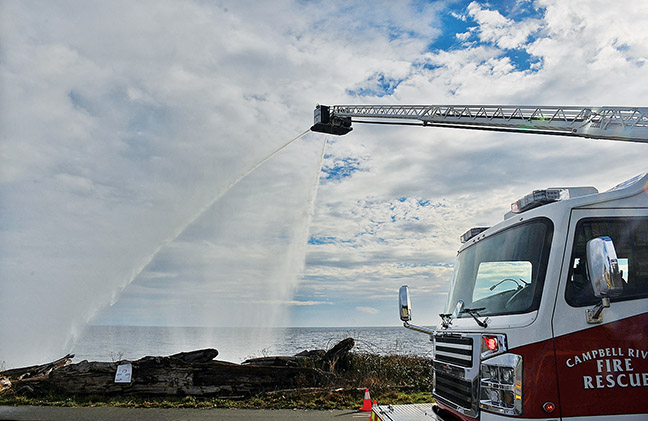While the public mainly see and hear the lights and sirens – and assume something is on fire and needs to be put out – and reads about why they were in such a hurry in the local newspaper afterwards, there is a whole lot more to the Campbell River Fire Department than hoses and fire hydrants.
The Fire Department provides a wide range of services to the community of Campbell River, the Strathcona Regional District, and three First Nations, including, yes, fire suppression, but also auto extraction, high-angle rope rescue, tower crane rescue and confined space rescue – which are exactly what they sound like.
On top of that, they also provide hazardous materials response in the event of a product spill, shore-based swiftwater rescue and are the community’s first medical response team, meaning they are the first ones called in the event of a medical emergency.
Oh, and let’s not forget they are also who gets called in the event someone gets stuck in an elevator, and are the ones who go to schools and other community organizations to do public education presentations, perform fire inspections on buildings, investigate the cause of fires when they happen, and assist with emergency disaster plan management and provide wildland and urban interface fire protection.
Many people don’t know that our local department also provides fire dispatch services from the No 1 Fire Hall downtown to 50 Fire Departments across Central and North Vancouver Island. These fire halls provide protective services from Nanoose Bay to the northern tip of Vancouver Island, including the Powell River area and the northern gulf islands – over 56,000 square km of area. They provide this service on behalf of the North Island 911 Corporation, and last year they dispatched over 10,000 calls.
In 2015 the department responded to 3,004 incidents themselves, and reported $31.7 million dollars in property value saved from fire loss where fires occurred.
The primary reason for the establishment of fire services in a community is to reduce the fire insurance costs for the community, according to Deputy Fire Chief Thomas Doherty. “As a result of the services provided by Campbell River Fire Department, the avoided insurance costs for the citizens of Campbell River are over $5 million annually, which is far greater than the overall operating costs of the department,” he says. “This reflects a cost benefit for every dollar spent on fire protection, a return of $1.63 to the citizens in avoided insurance costs.”
In 2016, Doherty says, “the department is focusing on completing a long term plan for fire service levels to the community as well as continuing to build partnerships to ensure a cost effective efficient service is provided to the citizens of Campbell River.”
And on top of everything else, the department also contributes more than 20,000 hours of volunteer time back to the community through various community programs and events such as coaching and assisting with various sports teams, school programs, participating in fundraising events and community groups, and their membership has also raised thousands of dollars from fundraising activities which is directed back into the community.
For more information on the Campbell River Fire Department, including recruitment information, head over to campbellriver.ca and look under “City Services.”
Who can resist a shiny new fire truck?
Not many, but Campbell Riverites got a look at their new, $994,000 fire truck on February, 11. It no sooner arrived in town and was put through its paces by undergoing a series of tests and drills.
“What you’re witnessing here right now is what’s called acceptance testing,” Chief Ian Baikie said at Ken Forde Park where the new truck was being tested mere hours after delivery. Acceptance testing is done to make sure the firefighting apparatus does what is expected before a cheque is handed over and the sale is completed.
Baikie said the truck is a new apparatus that displaces the 1993 aerial ladder truck which formed the department’s main piece of equipment. It is being retained. The new truck, which is being called Tower 1, will handle six storey buildings like the Berwick retirement home and the new hospital, under construction.
